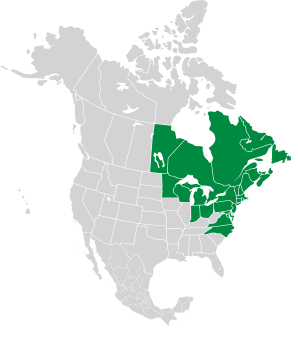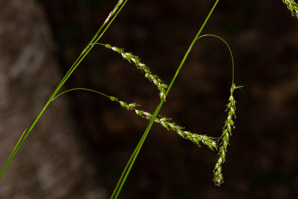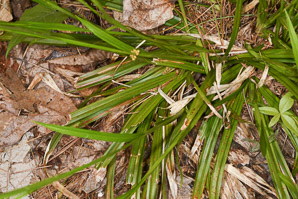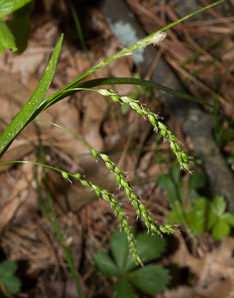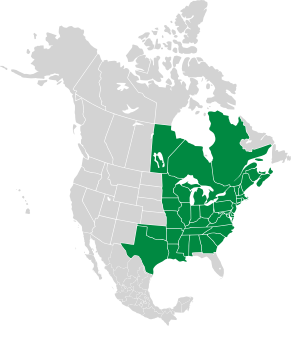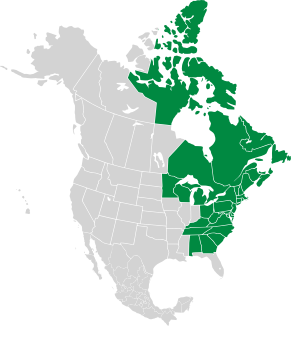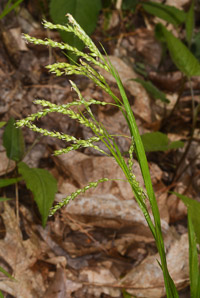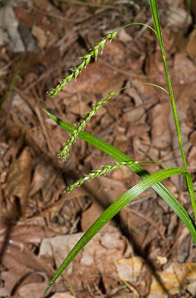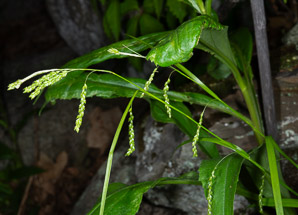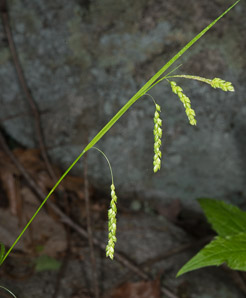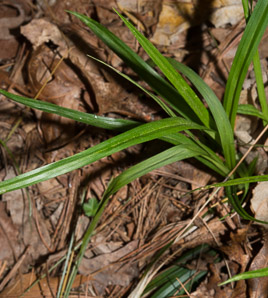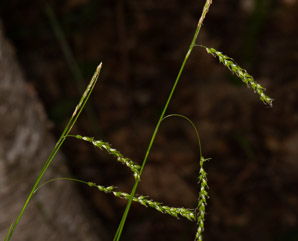
|
Carex arctata Boott ex Hook. Drooping wood sedge, drooping woodland sedge
This species is native to, and common in, New England and eastern Canada. They prefer rich, damp forested areas. Plants: Occurring in dense tufts, plants are up to 3′ (1 m) high. Leaves: Basal or nearly so. Grasslike leaves are ⅛-⅜″ (3-10 mm) wide. At the base, they are encased in a sheath that is pink to reddish purple. As if often the case with sedges, younger leaves have an ‘M’ or ‘W’-shaped cross-section. Flowers: Male (staminate) and female (pistillate) spikes are separate. The topmost spike is unisexual, staminate, ⅞-3 ⨉ 1/16-⅛″ (2.5-8 cm ⨉ 3-4 mm). 2-5 pistillate (also called carpellate) spikes appear lower on the stem. Each spike is up to 3″ (8 cm) long, and slender. Young spikes point upward, but they droop with age. Fruits: Achenes are ~1/16″ long ⨉ 1/32-1/16″ wide (1.7-2.6 ⨉ 0.8-1.7 mm). Online References:
References:
Some similar species: |
6/13/2021 · Cathance River Nature Preserve, Topsham, Maine · ≈ 6 × 4″ (15 × 10 cm) 5/18/2016 · Worcester Road, Beaver Brook Conservation Area, Hollis, New Hampshire 5/16/2014 · Acton Arboretum, Action, Massachusetts · ≈ 5 × 8″ (13 × 19 cm) |
||||||||||||||||||||||||||||
|
| |||||||||||||||||||||||||||||
| You are here Carex arctata |
Carex crinita |
Carex gynandra |
|||||||||||||||||||||||||||
|---|---|---|---|---|---|---|---|---|---|---|---|---|---|---|---|---|---|---|---|---|---|---|---|---|---|---|---|---|---|
| Common Name |  |
 |
 |
||||||||||||||||||||||||||
| Plant | Occurring in dense tufts, plants are up to 3′ (1 m) high. | Up to 4½′ (1.4 m) tall. | Up to 4½′ (1.4 m) tall. | ||||||||||||||||||||||||||
| Flowers | Male (staminate) and female (pistillate) spikes are separate. The topmost spike is unisexual, staminate, ⅞-3 ⨉ 1/16-⅛″ (2.5-8 cm ⨉ 3-4 mm). 2-5 pistillate (also called carpellate) spikes appear lower on the stem. Each spike is up to 3″ (8 cm) long, and slender. Young spikes point upward, but they droop with age. | Drooping narrow cylindrical heads up to 4½″ (11 cm) long and ¼″ (7 mm) in diameter. Carpellate scales are pale, truncate to notched at apex, with rough-textured awns. 1-3 staminate spikes per stem. | 2-5 carpellate narrow, cylindrical spikes per stem. Each spike is ⅞-4″ (2.4-10 cm) long, ⅛-¼″ (3-9 mm) in diameter. Scales on the carpels are pale- to copper brown. There are 1-3 staminate spikes per stem. | ||||||||||||||||||||||||||
| Leaves | Basal or nearly so. Grasslike leaves are ⅛-⅜″ (3-10 mm) wide. At the base, they are encased in a sheath that is pink to reddish purple. Younger leaves have an ‘M’ or ‘W’-shaped cross-section. | M or U-shaped in cross-section, ⅛-⅜″ (4-10 mm) wide. | ⅛-⅜″ (4-10 mm) wide, U-shaped. | ||||||||||||||||||||||||||
| Stem | Triangular stem cross-section. Basal leaf sheaths are smooth. | Rough-textured, with a triangular cross-section. Basal leaf sheaths are rough. | |||||||||||||||||||||||||||
| Fruit | Achenes are ~1/16″ long ⨉ 1/32-1/16″ wide (1.7-2.6 ⨉ 0.8-1.7 mm). | Perigynia are spreading, slightly inflated obovoid (widest above the middle and truncate), 1/16-⅛″ (2-4 mm) long. | Perigynia are oval-shaped, tapering to a small beak. | ||||||||||||||||||||||||||
| Range/ Zones |
|
|
|
||||||||||||||||||||||||||
| Habitats | Rich, damp forested areas. | Bottomland prairies, moist upland prairies, margins of bodies of water, spring branches, fens. | Marshes, wet forests, swamps, seeps, and roadside ditches. Perhaps a little more weedy and abundant in acidic soils than C. crinita. | ||||||||||||||||||||||||||
| Type | Wild | Wild | Wild | ||||||||||||||||||||||||||
Carex gracillima

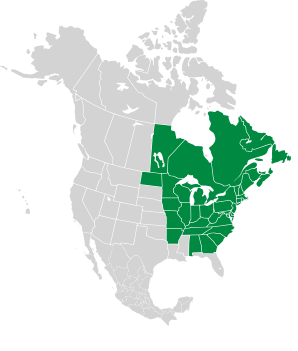
5/18/2016 · Worcester Road, Beaver Brook Conservation Area, Hollis, New Hampshire 
5/16/2014 · Acton Arboretum, Action, Massachusetts · ≈ 5 × 8″ (13 × 19 cm) ![]() ID is uncertain
ID is uncertain 
5/30/2014 · Tom and Susan’s, Pepperell, Massachusetts · ≈ 9 × 6″ (22 × 15 cm) ![]() ID is uncertain
ID is uncertain 
Carex arctata description by Thomas H. Kent, last updated 8 Sep 2023.
© FloraFinder.org. All rights reserved.
5/30/2014 · Tom and Susan’s, Pepperell, Massachusetts · ≈ 9 × 6″ (22 × 15 cm) ![]() ID is uncertain
ID is uncertain 
5/16/2014 · Acton Arboretum, Action, Massachusetts · ≈ 5 × 8″ (13 × 19 cm) ![]() ID is uncertain
ID is uncertain 
6/13/2021 · Cathance River Nature Preserve, Topsham, Maine · ≈ 7 × 4½″ (17 × 11 cm) 
Range:
